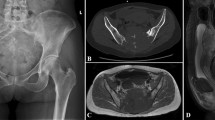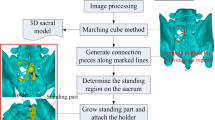Abstract
Purpose
Spinopelvic reconstruction after sacral tumour resection is one of the most demanding procedures in sacral tumour surgery. The aims of this study were to evaluate the feasibility of spinopelvic reconstruction with 3D-printed prostheses in sacral giant cell tumours and the clinical outcomes and complications at follow-up.
Methods
We retrospectively analyzed ten consecutive patients with giant cell tumors of the sacrum who underwent intralesional nerve-sparing resection with curative intent and custom implant reconstruction between 2016 and 2021. There were four males and six females with a mean age of 40.2 years (range, 25–62 years) at surgery. A computer-aided-design implant was prepared using 3D printing technology that was both matched to the bone defect and biomechanically evaluated. A 3D-printed surgical guide was used to replicate the resection procedure as planned. We analyzed operational outcomes, oncological outcomes, functional outcomes, complications, and prosthetic outcomes. Pain at rest was assessed according to a 10-cm VAS score. The results of functional improvement were evaluated using the MSTS-93 score at the final follow-up.
Results
All patients were observed for 26 to 61 months, with an average follow-up of 43.8 months. No deep infection or prosthetic structural failure occurred in this study. A total of 80% of patients had good neurological function and normal urinary, bowel, and ambulatory functions. The mean MSTS score was 24.1 (range, 22–26). The mean VAS score was 2 (range 0 to 2). Delayed wound healing occurred in three patients, and the wounds healed after debridement. One case had local recurrence and survived tumour-free after resection of the recurrent lesion. An aseptic loosening was found in a patient that did not require secondary surgery. By radiographical assessments, we found that 90% of implants were well osseointegrated at the final follow-up examination.
Conclusions
The 3D-printed sacral implants might provide a promising strategy for spinopelvic reconstruction in sacral giant cell tumours undergoing intralesional nerve-sparing surgery with satisfactory clinical outcomes, osseointegration, and excellent durability.




Similar content being viewed by others
Data availability
The data of this study are available from the corresponding author upon reasonable request.
Code availability
Not applicable.
References
Bukata SV, Blay JY, Rutkowski P et al (2021) Denosumab treatment for giant cell tumor of the spine including the sacrum. Spine (Phila Pa 1976) 46(5):277–284
Thangaraj R, Grimer RJ, Carter SR, Stirling AJ, Spilsbury J, Spooner D (2010) Giant cell tumour of the sacrum: a suggested algorithm for treatment. Eur Spine J 19:1189–1194
Wang J, Du Z, Yang R, Tang X, Yan T, Guo W (2020) Analysis of clinical outcome for adolescent patients undergoing conservative nerve-sparing surgery based on the proposed resection classification for sacral giant cell tumor. J Clin Neurosci 80:23–29
Reynolds JJ, Khundkar R, Boriani S et al (2016) Soft tissue and bone defect management in total sacrectomy for primary sacral tumors: a systematic review with expert recommendations. Spine (Phila Pa 1976) 41(Suppl 20):S199–S204
Tang X, Yang R, Qu H, Cai Z, Guo W (2018) Factors associated with spinopelvic fixation mechanical failure after total sacrectomy. Spine (Phila Pa 1976) 43(18):1268–1274
Bederman SS, Shah KN, Hassan JM, Hoang BH, Kiester PD, Bhatia NN (2014) Surgical techniques for spinopelvic reconstruction following total sacrectomy: a systematic review. Eur Spine J 23:305–319
Tong Y, Kaplan DJ, Spivak JM, Bendo JA (2020) Three-dimensional printing in spine surgery: a review of current applications. Spine J 20:833–846
Chatain GP, Finn M (2020) Compassionate use of a custom 3D-printed sacral implant for revision of failing sacrectomy: case report. J Neurosurg Spine 33(4):513–518. https://doi.org/10.3171/2020.3.SPINE191497
Kim D, Lim JY, Shim KW, Han JW, Yi S, Yoon DH, Kim KN, Ha Y, Ji GY, Shin DA (2017) Sacral reconstruction with a 3D-printed implant after hemisacrectomy in a patient with sacral osteosarcoma: 1-year follow-up result. Yonsei Med J 58:453–457
Wei R, Guo W, Yang R, Tang X, Yang Y, Ji T, Liang H (2019) Reconstruction of the pelvic ring after total en bloc sacrectomy using a 3D-printed sacral endoprosthesis with re-establishment of spinopelvic stability: a retrospective comparative study. Bone Joint J 101-B:880–888
Wei R, Guo W, Ji T, Zhang Y, Liang H (2017) One-step reconstruction with a 3D-printed, custom-made prosthesis after total en bloc sacrectomy: a technical note. Eur Spine J 26:1902–1909
Lv ZR, Li ZF, Yang ZP, Li X, Yang Q, Li K, Li J (2020) One-step reconstruction with a novel suspended, modular, and 3D-printed total sacral implant resection of sacral giant cell tumor with preservation of bilateral S(1–3) nerve roots via a posterior-only approach. Orthop Surg 12:58–66
Domovitov SV, Chandhanayingyong C, Boland PJ, McKeown DG, Healey JH (2016) Conservative surgery in the treatment of giant cell tumor of the sacrum: 35 years’ experience. J Neurosurg Spine 24:228–240
Hugate RR Jr, Dickey ID, Phimolsarnti R, Yaszemski MJ, Sim FH (2006) Mechanical effects of partial sacrectomy: when is reconstruction necessary. Clin Orthop Relat Res 450:82–88
Allen BL Jr, Ferguson RL (1984) The Galveston technique of pelvic fixation with L-rod instrumentation of the spine. Spine (Phila Pa 1976) 9:388–394
Peng L, Wang P, Jiang W, Cheng C, Zuo W, Qu Y, Li W (2020) Reconstruction with a 3D-printed prosthesis and internal fixation with novel four-rod technique after en bloc resection of meningiomas in the lumbosacral region (L5–S3) without rectum/bladder function sacrifice: technical case report. Turk Neurosurg 30:632–635
Paredes SR, Smigielski M, Stalley PD, Lee PJ (2022) Pelvic exenteration with high sacrectomy and reconstruction with 3D-printed prosthesis for recurrent sacral chordoma. ANZ J Surg. https://doi.org/10.1111/ans.17952
Angelini A, Trovarelli G, Berizzi A, Pala E, Breda A, Ruggieri P (2019) Three-dimension-printed custom-made prosthetic reconstructions: from revision surgery to oncologic reconstructions. Int Orthop 43:123–132
Wang B, Hao Y, Pu F, Jiang W, Shao Z (2018) Computer-aided designed, three dimensional-printed hemipelvic prosthesis for peri-acetabular malignant bone tumour. Int Orthop 42:687–694
Wang J, Min L, Lu M, Zhang Y, Wang Y, Luo Y, Zhou Y, Duan H, Tu C (2020) What are the complications of three-dimensionally printed, custom-made, integrative hemipelvic endoprostheses in patients with primary malignancies involving the acetabulum, and what is the function of these patients. Clin Orthop Relat Res 478:2487–2501
Li D, Guo W, Qu H et al (2013) Experience with wound complications after surgery for sacral tumors. Eur Spine J 22(9):2069–2076
Lim CY, Liu X, He F, Liang H, Yang Y, Ji T, Yang R, Guo W (2020) Retrospective cohort study of 68 sacral giant cell tumours treated with nerve-sparing surgery and evaluation on therapeutic benefits of denosumab therapy. Bone Joint J 102-B:177–185
Guo W, Ji T, Tang X, Yang Y (2009) Outcome of conservative surgery for giant cell tumor of the sacrum. Spine (Phila Pa 1976) 34:1025–1031
Liang H, Liu X, Yang Y et al (2022) Ultra-short course of neo-adjuvant denosumab for nerve-sparing surgery for giant cell tumor of bone in sacrum. Spine (Phila Pa 1976) 47(9):691–701
Kato I, Furuya M, Matsuo K, Kawabata Y, Tanaka R, Ohashi K (2018) Giant cell tumours of bone treated with denosumab: histological, immunohistochemical and H3F3A mutation analyses. Histopathology 72:914–922
Xiang F, Liu H, Deng J, Ma W, Chen Y (2022) Progress on denosumab use in giant cell tumor of bone: dose and duration of therapy. Cancers (Basel) 14(23):5758. https://doi.org/10.3390/cancers14235758
Hashimoto K, Nishimura S, Miyamoto H, Toriumi K, Ikeda T, Akagi M (2022) Comprehensive treatment outcomes of giant cell tumor of the spine: a retrospective study. Medicine (Baltimore) 101:e29963
Acknowledgements
We are grateful to the participants who volunteered in this study.
Funding
This research was funded by the Shandong Provincial Natural Science Foundation, grant number ZR2021MH114.
Author information
Authors and Affiliations
Contributions
All authors contributed to the study’s conception and design. Material preparation, data collection, and analysis were performed by Zhenfeng Li, Zhaorui Lv, and Jianmin Li. The first draft of the manuscript was written by Zhaorui Lv, and all authors commented on previous versions of the manuscript. All authors read and approved the final manuscript.
Corresponding author
Ethics declarations
Ethical approval
The study was conducted in accordance with the Declaration of Helsinki and approved by the Medical Ethics Committee of Qilu Hospital of Shandong University (protocol code 2015087 and approved on December 28, 2015).
Consent to participate
Informed consent was obtained from all individual participants included in the study.
Consent for publication
The authors affirm that human research participants provided informed consent for publication of the images in Figs. 1 and 4.
Conflict of interest
The authors declare no competing interests.
Additional information
Publisher's note
Springer Nature remains neutral with regard to jurisdictional claims in published maps and institutional affiliations.
Supplementary Information
Below is the link to the electronic supplementary material.
Supplementary file1 (MP4 44675 KB)
Supplementary file2 (MP4 49421 KB)
Rights and permissions
Springer Nature or its licensor (e.g. a society or other partner) holds exclusive rights to this article under a publishing agreement with the author(s) or other rightsholder(s); author self-archiving of the accepted manuscript version of this article is solely governed by the terms of such publishing agreement and applicable law.
About this article
Cite this article
Lv, Z., Li, J., Yang, Z. et al. A novel three-dimensional-printed patient-specific sacral implant for spinopelvic reconstruction in sacral giant cell tumour. International Orthopaedics (SICOT) 47, 1619–1628 (2023). https://doi.org/10.1007/s00264-023-05759-0
Received:
Accepted:
Published:
Issue Date:
DOI: https://doi.org/10.1007/s00264-023-05759-0




